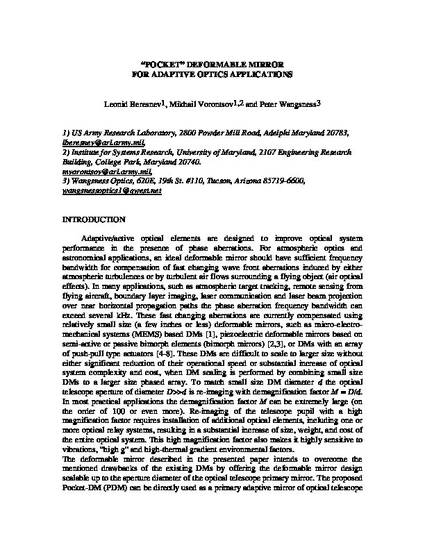
Adaptive/active optical elements are designed to improve optical system performance in the presence of phase aberrations. For atmospheric optics and astronomical applications, an ideal deformable mirror should have sufficient frequency bandwidth for compensation of fast changing wave front aberrations induced by either atmospheric turbulences or by turbulent air flows surrounding a flying object (air optical effects). In many applications, such as atmospheric target tracking, remote sensing from flying aircraft, boundary layer imaging, laser communication and laser beam projection over near horizontal propagation paths the phase aberration frequency bandwidth can exceed several kHz. These fast-changing aberrations are currently compensated using relatively small size (a few inches or less) deformable mirrors, such as micro-electromechanical systems (MEMS) based DMs [1], piezoelectric deformable mirrors based on semi-active or passive bimorph elements (bimorph mirrors) [2,3], or DMs with an array of push-pull type actuators [4-8]. These DMs are difficult to scale to larger size without either significant reduction of their operational speed or substantial increase of optical system complexity and cost, when DM scaling is performed by combining small size DMs to a larger size phased array. To match small size DM diameter d the optical telescope aperture of diameter D>>d is re-imaging with demagnification factor M = D/d. In most practical applications the demagnification factor M can be extremely large (on the order of 100 or even more). Re-imaging of the telescope pupil with a high magnification factor requires installation of additional optical elements, including one or more optical relay systems, resulting in a substantial increase of size, weight, and cost of the entire optical system. This high magnification factor also makes it highly sensitive to vibrations, “high g” and high-thermal gradient environmental factors. The deformable mirror described in the presented paper intends to overcome the mentioned drawbacks of the existing DMs by offering the deformable mirror design scalable up to the aperture diameter of the optical telescope primary mirror. The proposed Pocket-DM (PDM) can be directly used as a primary adaptive mirror of optical telescope and laser beam delivery system eliminating the need for additional optical elements used for incorporation of a small size DM into telescope optical train.
Available at: http://works.bepress.com/mikhail_vorontsov/2/

Paper is made available for download with the permission of the publisher and the author. Permission documentation is on file.